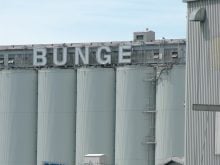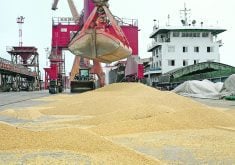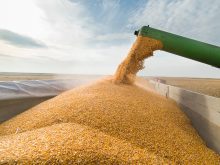A terrorist attack on agriculture in the United States and Canada could have a devastating impact on prairie farmers and Canadian society.
But while most farmers and citizens haven’t thought about agriculture as a terrorist target, Canadian and American government officials had already made response plans for agri-terrorism before the Sept. 11 attack in the U.S.
“The threat is low, but the consequences are high,” said Graham Clarke, director of Agriculture Canada’s animal industry branch.
“It wouldn’t necessarily cause terror, but it could cause disruption and even destabilize the government.”
Read Also

Defence investments could benefit agriculture
A bump in Canada’s NATO spending commitments could lead to infrastructure investments that would benefit rural areas
Farms are open to animal or plant diseases. The food sector is vulnerable to diseases, poisons or other contaminants. Clarke has been representing the agriculture department in government-wide meetings designed to produce a strategy for combating terrorism and minimizing its impact on Canadian society.
He said one of his biggest jobs has been making people understand that agriculture could be a target.
“Most of them really had no idea,” said Clarke. “In the past when people worked on terrorism, they really thought more about threats to the human population than about threats to animals or crops.”
But the severe disruptions and massive costs that animal diseases can cause have become evident in recent years through events not linked to terrorism.
The recent outbreak of foot-and-mouth disease caused billions of dollars damage to the British economy. Mad cow disease also took a similar financial toll, deeply disturbed the non-farming population, and, some people believe, helped bring down the British government of the day. Mad cow disease is still plaguing many European countries and recently appeared in Japan.
Pig diseases in Taiwan and Holland also cost farmers in those countries, and disrupted the national economies.
Clarke said agriculture officials have been analyzing the threat of agri-terrorism for a couple of years. They have met with American, British and Australian officials in the past year to discuss the threat and how to deal with any attack.
Those discussions have now been sped up because of the Sept. 11 attack.
The Canadian Food Inspection Agency has contingency plans to deal with sudden outbreaks of disease. That is its job. And Clarke said the agency is always watching to catch any disease found in the farm or food sector.
“It really doesn’t matter whether it’s naturally introduced or if someone introduces it as an act of economic sabotage.”
Greg Orriss, the inspection agency’s director of the bureau of food safety and consumer protection, said its officials know about the possibility of an attack on Canadian agriculture and are looking out for “anything anomalous.”
They won’t necessarily react differently to a human-introduced disease, but have integrated a higher sense of risk into their plans. Orriss said they have looked at the possibility of several outbreaks occurring at once, something that doesn’t generally happen with naturally introduced diseases.
Clarke said there isn’t much farmers can do to help minimize the threat. Livestock producers are already sensitive to the potential of disease outbreaks in their herds, and crop growers regularly survey their fields.
Staying vigilant is the most farmers can probably do.
“Be aware of strange things,” Clarke said.















